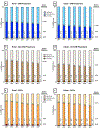Rising high-acuity emergency care services independently billed by advanced practice providers, 2013 to 2019
- PMID: 36334276
- PMCID: PMC10973948
- DOI: 10.1111/acem.14625
Rising high-acuity emergency care services independently billed by advanced practice providers, 2013 to 2019
Abstract
Background: Advanced practice providers (APPs) comprise an increasing proportion of the emergency medicine (EM) workforce, particularly in rural geographies. With little known regarding potential expanding practice patterns, we sought to evaluate trends in independent emergency care services billed by APPs from 2013 to 2019.
Methods: We performed a repeated cross-sectional analysis of emergency clinicians independently reimbursed for at least 50 evaluation and management (E/M) services (99281-99285, 99291) from Medicare Part B, with high-acuity services including Codes 99285 and 99291. We describe the outcome proportion of E/M services by acuity level and report at (1) the encounter level and (2) at the clinician level. We stratified analyses by clinician type and geography.
Results: A total of 47,323 EM physicians, 10,555 non-EM physicians, and 26,599 APPs were included in analyses. APPs billed emergency care services independently for 5.1% (rural 7.3%, urban 4.8%) of all high-acuity encounters in 2013, increasing to 9.7% (rural 16.4%, urban 8.8%) by 2019. At the clinician level, in 2013, the average rural-practicing APP independently billed 22.8% of services as high acuity, 72.6% as moderate acuity, and 4.5% as low acuity. By 2019, the average rural-practicing APP independently billed 36.2% of services as high acuity, representing a +58.8% relative increase from 2013. Relative increases in high-acuity visits independently billed by APPs were substantially greater when compared to EM physicians across both rural and urban geographies.
Conclusions: In 2019, APPs billed independent services for approximately one in six high-acuity ED encounters in rural geographies and one in 11 high-acuity ED encounters in urban geographies, and well over one-third of the average APPs' encounters were for high-acuity E/M services. Given differences in training and reimbursement between clinician types, these estimates suggest further work is needed evaluating emergency care staffing decision making.
Keywords: emergency medicine; nurse practitioners; physician assistants; rural health; visit acuity.
© 2022 Society for Academic Emergency Medicine.
Conflict of interest statement
Conflict of Interest Disclosure:
CJG and AKV are members of the Society for Academic Emergency Medicine’s Workforce Committee.
Figures


Comment in
-
How to effectively integrate advanced practice providers into the ED workforce.Acad Emerg Med. 2023 Feb;30(2):154-156. doi: 10.1111/acem.14633. Epub 2022 Dec 15. Acad Emerg Med. 2023. PMID: 36445097 No abstract available.
-
Reply to "Response to rising high-acuity emergency care services independently billed by advanced practice providers, 2013 to 2019".Acad Emerg Med. 2023 Sep;30(9):982-983. doi: 10.1111/acem.14715. Epub 2023 Mar 22. Acad Emerg Med. 2023. PMID: 36869651 No abstract available.
-
Response to "Rising high-acuity emergency care services independently billed by advanced practice providers, 2013 to 2019".Acad Emerg Med. 2023 Sep;30(9):980-981. doi: 10.1111/acem.14713. Epub 2023 Mar 21. Acad Emerg Med. 2023. PMID: 36871137 No abstract available.
References
-
- Nelson SC, Hooker RS. Physician assistants and nurse practitioners in rural Washington emergency departments. J Physician Assist Educ 2016;27(2):56–62. - PubMed
-
- Marco CA, Courtney DM, Ling LJ, et al. The emergency medicine physician workforce: projections for 2030. Ann Emerg Med 2021;78(6):726–37. - PubMed
-
- Carpenter CR, Abrams S, Courtney DM, et al. Advanced practice providers in academic emergency medicine: a national survey of chairs and program directors. Acad Emerg Med 2022;29(2):184–92. - PubMed
-
- Hooker RS, Klocko DJ, Larkin GL. Physician assistants in emergency medicine: the impact of their role. Acad Emerg Med 2011;18(1):72–7. - PubMed
Publication types
MeSH terms
Grants and funding
LinkOut - more resources
Full Text Sources
Medical

